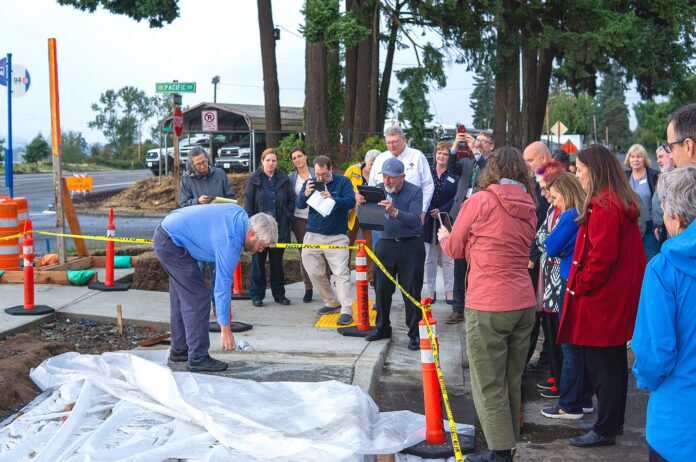
City officials last month took a victory lap through more than two dozen transformative traffic and safety projects dotted around town as the ambitious Tualatin Moving Forward project entered its final phase.
The five-year, $20 million bond pinpointed problem spots, aiming to get motorists around more quickly and to create safer pedestrian access to schools, public transportation, parks, shopping, and medical centers.
The result is widened roads, high visibility pedestrian crossings, new bike lanes, smoother ADA-accessible sidewalks, new stormwater drainage systems, art, and additional lanes aimed at shaving precious minutes of off daily commute times.
“As of today, all of the Tualatin Moving Forward projects are now in active construction,” said senior transportation engineer Mike McCarthy.
McCarthy acted as emcee and tour guide for city councilors, Mayor Frank Bubenik, and other officials on a bus ride that looped through the city.
Voters approved the bond measure in May 2018. Four years in, at the end of 2022, 24 projects were complete, with another 12 slated for “The Year of Transportation Construction,” 2023.
Among the most ambitious is a $2.7 million fall project, one of the last, that will widen the city’s busiest intersection, adding a third eastbound lane to Southwest Tualatin-Sherwood Road between Southwest Martinazzi Avenue and Interstate 5, which engineering studies predict will trim drive times.
The new configuration includes narrowing medians and restriping the pavement to squeeze in another eastbound additional lane.
“As it is right now, a lot of people get bogged down in the right lane coming eastbound on Tualatin Sherwood Road,” McCarthy said. He estimates about 80 percent of that traffic is headed for the freeway.
The third lane, created by restriping, will separate north and southbound access with the right lane leading to I-5 south, the center lane leading to I-5 north, and a left lane that can be used to either access the north onramp or crossover the freeway to Nyberg Street.
Now, marked signs guide drivers to the correct lane.
“We’ve also done quite a bit of work to upgrade sidewalks and curve ramps to meet Americans with Disabilities Act standards,” he said.
Bicyclists also will see a new path coming out of construction.
But adding a bike lane, which Oregon law requires with new driving lanes, is tricky because of space constraints caused by Fred Meyer’s loading dock.
The new buffered bike route leads riders to the Tualatin River Greenway Trail, passing underneath the freeway.
“We did a lot to improve the bike lane connection from Tualatin-Sherwood/Boones Ferry to the trail under I-5 as an alternative route,” McCarthy said. “I think it’s a much nicer alternative route.”
Roadwork could cause nighttime closures and is targeted for completion by the end of the year.
Voters approved the bond measure in May 2018.
“One of the things staff and we all promised five years ago is that this would be all done in five years,” Bubenick said. “Even though it’s a 10-year bond, we committed to having it all done and proving to the community that these projects could be delivered on time and on budget, and that’s what we’re doing.”
As the calendar flips into the final quarter, the city is within reach of hitting its target.
Throughout the tour, McCarthy pointed out sidewalks upgraded to meet ADA standards and mid-block pedestrian crosswalks installed to usher walkers safely to parks, schools, shopping areas, and hospitals, like a mid-block crossing from Meridian Park Hospital to apartments and nearby restaurants.
In one of the program’s earliest projects, a pedestrian-activated flashing signal was added to a crosswalk leading from a residential neighborhood to Atfalati Park at Southwest Sagert Street near Southwest 67th Avenue.
It’s one of 30 such beacons added to crosswalks around the city during the project, 25 of them covered by the bond and the remaining five through other funding.
Southwest Martinazzi Avenue and Southwest Sagert Street, another of the city’s busiest intersections, got new sidewalks and high-visibility crosswalks.
The former 4-way stop also now has a traffic signal.
“We’ve heard a lot of positives about (the traffic signal),” McCarthy said, adding some people asked “why didn’t you build it 20 years ago.”


















